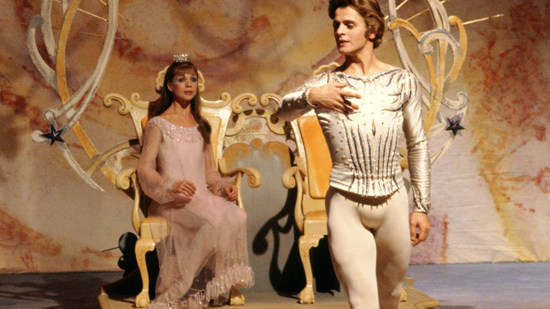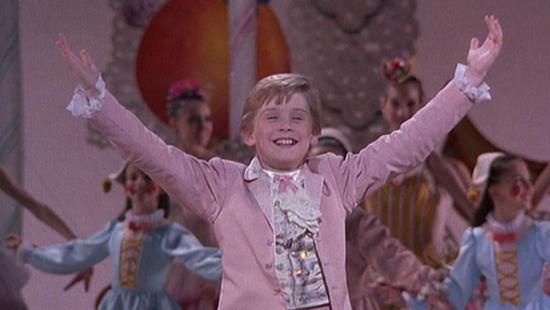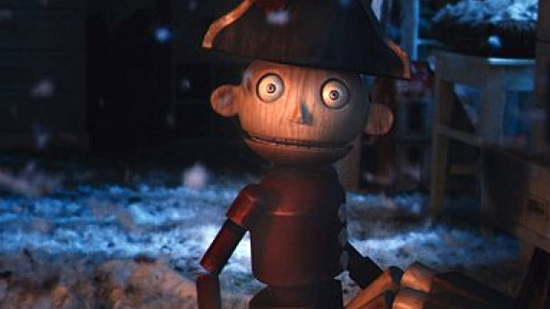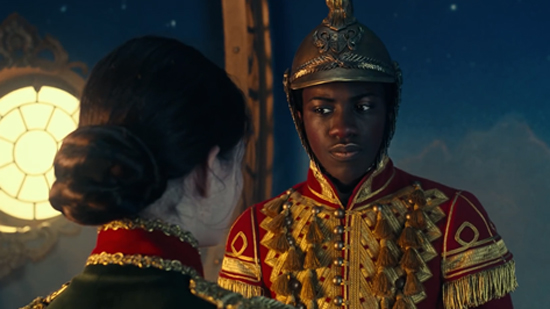
There are plenty of classic tales that have over time become favorites around Christmas time. There is of course Charles Dickens’ A Christmas Carol, as well as more contemporary stories that have come out of the movies like It’s a Wonderful Life (1946) and Miracle on 34th Street (1947). But if there is one story that has certainly become almost synonymous with the holidays and it renowned around the world, it is the classic tale of the Nutcracker. The story first emerged in 1816 as a short story written by German Romantic author E. T. A. Hoffman. The story titled “The Nutcracker and the Mouse King” is about a young child’s favorite toy coming to life on Christmas Eve to save her from the wicked Mouse King and then after the battle whisks the girl away to his magical kingdom of real live dolls where they crown her queen. It’s a charming fairy tale for children and it unsurprisingly quickly became a favorite story across Europe at the time. Numerous adaptations were made in other languages at the height of it’s popularity, including a French one written by famed author Alexander Dumas. But, it was when the story reached the cultural circles of Russia that it fell into the hands of one of the story’s most important figures. That man was composer Pyotr Ilyich Tchaikovsky, who in 1892 took this familiar tale and used it as the inspiration for his new ballet score. While Hoffman was the one who created the tale, it was Tchaikovsky who made it immortal. One cannot imagine the story of the Nutcracker now without the accompaniment of Tchaikovsky’s musical themes. It’s also why today the story is retold today, more often than not, in the form of a ballet performance. This is certainly true of the many film adaptations of the story that have been made, which almost all have at least some ballet elements. Below are a few of the most noteworthy representations of the character of the Nutcracker on the big screen, which either vary close to the original intention of Hoffman’s story and Tchaikovsky’s ballet or take the character and his story in very wild and unexpected directions.

MIKAIL BARYSHNIKOV in THE NUTCRACKER (1977)
It helps to start with an adaptation that sticks pretty close to the Tchaikovsky ballet that most people are familiar with. This production was staged by the American Ballet Theater (ABT) and was aired on CBS stations during the holidays. It’s also noteworthy for having the lead role being played by one of the most famous dancers of that era. Baryshnikov was at this point starting to become a household name not just in the world of ballet theater, but also in film as well. This staging came just mere months after his star making role in the film The Turning Point (1977) co-starring Shirley MacLaine and Anne Bancroft. His small role as a womanizing Russian dancer stole the film and he earned an Oscar nomination the following year for his performance. Not bad for someone who was just emerging onto the scene in the prestigious New York based ABT. He also made headlines years prior for his public defection from the Soviet Union, gaining asylum in Canada before making his way to New York. Suffice to say, this was a version of the famed ballet that benefitted from featuring a star that was well on the rise. It goes without saying that Baryshnikov excels in the film with his athletic command of the ballet stage. The overall presentation is what you would expect of a filmed version of a stage performance. From what I’ve gathered, this is the only time he has played the part on both stage and screen, given that he was already 29 at the time of the recording of this performance and this is a role that typically is filled by younger dancers. Still, those looking for a more pure, traditional staging of this story in it’s ballet form will be satisfied with the version of it here, as well as have the opportunity to see a dancer of Baryshnikov’s stature filling out the iconic, titular role.

RODDY MCDOWALL in NUTCRAKER FANTASY (1979)
A story with high fantasy like “The Nutcracker” is almost certainly going to receive the animated treatment eventually. What is surprising is that the biggest name in animation, The Walt Disney Company, passed on adapting this familiar story into it’s own film; at least initially. They instead took Tchaikovsky’s score and animated a pastoral montage of nature set to music for a segment in the film Fantasia (1940). A true animated feature based on the story of the Nutcracker wouldn’t come until 1979, when we received this stop-motion animated film based very loosely on the original story. Despite it’s strong resemblance to the stop-motion holiday specials by Rankin Bass, this feature was actually a Japanese production made by the Sanrio company, who are most famous for their Hello Kitty character. The story of the Nutcracker in this film borrows a bit more from “The Wizard of Oz” than it does from the Hoffman tale, with the girl Clara spending much more of her story in the toy kingdom. The character of the Nutcracker, here called Franz, is very different from the version we are all familiar with, being more of an appointed protector of Clara rather than a driving force in the story himself. Unlike in the original story, the curse that makes him a nutcracker happens late in the film rather than being a factor in his introduction. And I don’t know if it’s a sign of the times, or a loss in translation through the Japanese interpretation of this classic story, but the film depicts a major age disparity between Franz and Clara that gets a little uncomfortable watching it today, especially when the two start showing romantic interest in one another. It might be a factor in the English voice casting as well, as the mature sounding Roddy McDowall contrasts heavily with the you sounding Melissa Gilbert in their respective roles. Aside from this, it’s an odd but still visually appealing animated presentation, and that strong resemblance to the Rankin Bass style certainly helps to give the movie a good holiday time feel. But, as far as true adaptation of this story, there are far better examples to choose from.

WADE WALTHALL in NUTCRACKER: THE MOTION PICTURE (1986)
Here we have what many proclaim to be the finest cinematic presentation of the ballet ever done. It’s essentially a filmed version of the ballet, this one put on by the Pacific Northwest Ballet Company based out of Seattle, Washington, with stagecraft and scenery based on the artwork of author and illustrator Maurice Sendak of “Where the Wild Things Are” fame. Sendak’s picture book adaptation of the original Hoffman story is a highly celebrated work of art on it’s own, but here we see it come to life along with the Tchaikovsky ballet, creating a truly surreal experience. What is great about this version is that the filmmakers took the same ballet from the stage, but they composed their shots like they were filming a real movie. Basically this is a version of the ballet performance meant primarily to be seen on the big screen. There are some incredible visual effects used to create an imaginative experience. Not only does the Nutcracker fight an army of mice led by the Mouse King, but the Mouse King is a grotesque, multi-headed monster that would feel at home in a Jim Henson fantasy epic like The Dark Crystal (1982). The Maurice Sendak element of it all also gives the film a lot of character, with characters presented with exaggerated features to make them look more closely like they jumped off of the page of Sendak’s drawings. Give credit to ballet dancer Wade Walthall, who has to perform his acrobatic moves with a giant nutcracker head on his shoulders. Most stagings of the ballet do require the Nutcracker performer to wear a mask during his first introduction, but the one in this film is ridiculously large in order to mimic the Sendak style, so it’s a testament to the talent of the dancer. While there is a quaintness to the visual effects of this version of the ballet, it is imaginative enough to help the whole movie stand out as one of the best versions ever captured on screen, and one that has another layer of an artist like Maurice Sendak adding his own visual flair to Hoffman’s story and Tchaikovsky’s music.

KEIFER SUTHERLAND in THE NUTCRACKER PRINCE (1990)
Since Disney chucked away the story of the Nutcracker in favor of animating to the music, it seems only natural that someone else would swoop in to take on the material themselves. Made by independent Hinton Animation Studios and released through Warner Brothers, this animated version sticks pretty closely to the original version of Hoffman’s story, but perhaps more than most theatrical versions seen, it puts the Nutcracker himself in a far more central part of the story. The film still centers around Clara and her journey, but the Nutcracker is far more than a secondary character here. He goes through his own character arc of having to re-establish his place as a monarch in the toy kingdom after a long absence away. It also puts more of a conflicting wedge between him and Clara as the condition for him being human again rests on Clara committing to staying by his side as his queen. Apart from that extra bit of character building, the movie is pretty simplistic for an animated film, which is more a result of having to stretch out Hoffman’s short story to feature length without the benefit of long dance routines to pad the time. The movie came in a transitionary time for animation, as Disney was in the middle of their Renaissance period, and animation standards were improving greatly. This movie can’t quite match the same Disney quality, but for a small independent animated project it nevertheless has ambition behind it, as well as a strange stylized backstory that feels like classic Looney Tunes. The voice cast is also noteworthy, with Keifer Sutherland (yes, Jack Bauer himself) playing the role of the Nutcracker. Of course this was made when he was still a young actor, but it is kind of strange associating that voice with this kind of character. This could be a good film to introduce younger audiences who don’t have the patience to sit through a ballet to the famed story, but in the grand scheme of things in animation, it leaves a lot to be desired when compared to what Disney was making at the time.

MACAULAY CULKIN in THE NUTCRAKCER (1993)
You may find this hard to believe, but right in the heart of his meteoric rise to fame following a starring role in Home Alone (1990), Macaulay Culkin also starred in a filmed ballet version of the Nutcracker. It’s actually not too far out of left field. Culkin in his childhood days before film stardom did take dancing lessons, though he was well short of being a professional ballet performer. Still, as he was beginning to be cast in more high profile movies, he was also given the opportunity to play the title character in this production of the Nutcracker, put together by the ABT and choreographer George Balanchine. This Balanchine staging was significant, because it broke with tradition in having young children play the roles of the Nutcracker Prince and Clara. Typically more experienced dancers play the roles, but here the roles are meant for younger performers with some of the more demanding routines given to the supporting cast, thereby making the staging more true to the original story. Culkin, for his part, fits the role fine and doesn’t feel too novice compared to the the more experienced dancers. But, anyone looking to see him play a more central role in this film version may be disappointed as it’s another staging that makes the Nutcracker a more passive player in the story. What’s interesting is that this movie sat on a shelf for years, even as Culkin’s profile in Hollywood was exploding. He shot the movie just shortly after he made the first Home Alone, but the film wasn’t released until even after he made Home Alone 2 (1992). By that time, Culkin had grown up a bit and his star power was not quite as strong as it once was. If you saw this movie in succession with his other movies at the time, you would see him de-age by about 3-4 years in a jarring change of pace for his career. Part of the reason for this was contract disputes with the makers of the film and Culkin’s father who managed his career, mainly over how Culkin’s presence in the movie would be publicized. It only led to this movie missing it’s prime moment and ultimately flopping at the box office. It was too long forgotten to impact Macaulay in any negative way, and the film ultimately pales in comparison to the Sendak version. But it is an interesting side note in the history of this character on the big screen, as at some point he was played by one of the biggest movie stars in the world at the time of it’s release.

SHIRLEY HENDERSON and CHARLIE ROWE in THE NUTCRACKER: THE UNTOLD STORY (2010)
There will probably never be an adaptation of The Nutcracker story as wild and misguided as this one. A long time passion project for Russian filmmaker Andrey Konchalovskiy, this version of the story only has a passing resemblance to the Hoffman original. The rest of this adaptation is filled in with a allegory to the Holocaust. You heard me right. Oh, and it’s a musical too. This is one bizarre movie, and not in a good way. The Nutcracker himself is also pretty off-putting, animated mostly as a CGI puppet with a disturbing looking, expressionless stare. Anyone who thinks that the Pinocchio puppet in Guillermo Del Toro’s new stop motion adaptation of that story is disturbing clearly hasn’t seen this version of the Nutcracker. Not only that, but actress Shirley Henderson’s vocal performance is screechy and obnoxious and not at all endearing. Thankfully, when the nutcracker turns into a real boy, played by Charlie Rowe, he sounds more natural, but most of the movie features the former rather than the latter. Just to show you how misguided Konchalovskiy’s adaptation is, the Rat King (played by a very hammy John Tuturro) subjugates the toys within a kingdom with very fascist overtones, to the point where he even begins to burn them in bonfires. Maybe allusions to the Holocaust may have worked if the movie fit that kind of tone consistently, but no, Konchalovskiy includes this kind of imagery with a whimsical tone that just makes the Holocaust allegory all the more out of place and offensive. This alone makes this the worst version of the Nutcracker ever adapted in any medium. But, there was a lot of other factors in this movie that make the whole thing a disaster, and the disturbing Nutcracker is chief among them. It’s honestly a movie that really goes out of it’s way to make everything that was great about the Nutcracker (it’s whimsical tale, the iconic music, it’s memorable) and do the complete worst thing possible with all of them.

JAYDEN FOWORA-KNIGHT in THE NUTCRACKER AND THE FOUR REALMS (2018)
Well, it took them almost 80 years, but Disney finally got around to making a true Nutcracker movie, or so you would think. Essentially, they are doing a Hook version of this story, based on the practice of making a sequel to a familiar story with characters returning to a fantasy world after a long absence, without having to make the original as a set up. The Nutcracker and the Four Realms is another movie from the Disney company that seems to have put the bulk of it’s resources into the art direction and far less into the story and script. It’s a hollow world-building exercise that in no way feels authentic and worth anyone’s time. One of the big problems in this version is despite being in the title of the film, the Nutcracker is a minor supporting player in this film. Jayden Fowora-Knight is decent, and it is interesting at least to see the part played by an actor of color, but the character matters so little in the grand scheme of the cliched story that you wonder at all why he’s a part of the title. It’s probably because without the name “Nutcracker,” no one would ever know it’s connected to the famous story. The Nutcracker himself, named Phillip this time, isn’t even cursed in this version, and never goes through a transformation from toy nutcracker to a real boy. We only connect him to the character purely by the way he dresses, as the typical foot soldier design that most nutcracker dolls are made to look like. If it weren’t for the travesty of Nutcracker: The Untold Story, Four Realms would likely be the disastrous production of this story ever put on screen. It had a notoriously complicated production, which led to one director (Lasse Hallstrom) being unable to finish the movie during re-shoots and another director hired at the last second (Joe Johnston) to finish what had been started. The end result, unsurprisingly lacks cohesion and substance, and not surprisingly it performed very poorly at the box office, dashing any hopes of a franchise. Still, as Untold Story proved, Disney could have done much worse. They should have followed Walt Disney’s original instinct and just work with the Tchaikovsky music.
So, there you have some of the most notable big screen versions of the Nutcracker character that audiences have been able to see. For the most part, The Nutcracker is a character that is better appreciated live on the stage during a ballet performance. There’s a reason why the ballet remains a favorite all these years later, especially as a key part of the holiday traditions. What is interesting is that Tchaikovsky himself was not fond of his ballet score, finding it unsatisfying and too simplistic compared to his more preferred complex works like Sleeping Beauty and Swan Lake. And yet, The Nutcracker compared to the rest is the most often staged, making it his most successful score overall. It’s only recently that we’ve been seeing film adaptations of the Hoffman story, because of the continued popularity of the ballet. And because of that enormous popularity, few of the film adaptations stray away from the ballet as well. The 1986 version with art design inspired by the drawings of Maurice Sendak is probably the best combination of the art of dance and cinema brought together that we’ve ever seen, but there are valiant attempts to fill the story with more than just beautiful choreography. The two animated versions from 1979 and 1990 do their best to fill Hoffman’s short story with more enriched character development and an expanded plot, even if they fall a little short. They certainly do a lot better than the live action films, with Untold Story being an especially notorious misfire that insultingly tries to add Holocaust allegory to this simple children’s fairy tale. Even if the big screen’s samplings have been fairly light, there are numerous stage versions across the country that are easy to find during the Holiday Season. It’s a production that is a part of every ballet company’s repertoire, and remarkably has shown to account for nearly 20% of all yearly ticket sales alone for those dance companies. That’s a real testament to the staying power of this story and it’s iconic status as a part of the Christmas season. Whether he’s dancing across the big screen, or on stages large and small across the world, or just sitting on a table or shelf as one of your Christmas decorations, The Nutcracker still remains an integral figure of everyone’s joyous Holiday experience.